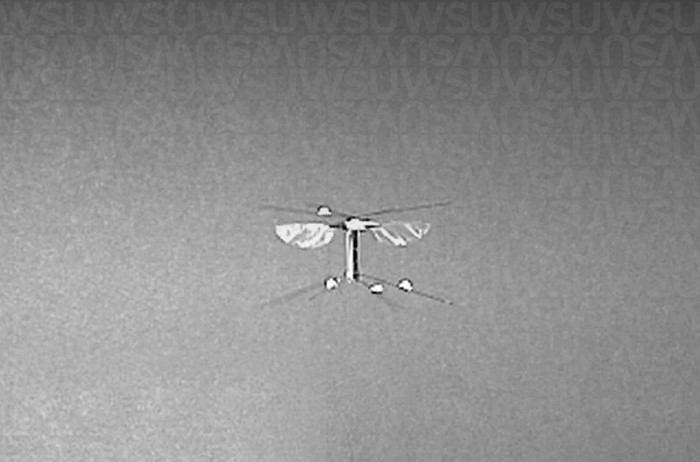Bee-Inspired Breakthrough: Twisty Robot Buzzes into Action!
Researchers at Washington State University have achieved a remarkable feat in robotics: they have developed a bee-inspired flying machine capable of maneuvering in all directions. The innovative robot, named Bee++, boasts four wings constructed from lightweight carbon fiber and mylar, along with four specially designed actuators to control each wing. Unlike previous models, Bee++ can flawlessly navigate the twisting motion known as yaw, exhibiting the full range of movement exhibited by real flying insects. This groundbreaking achievement opens up new possibilities for robotics and could pave the way for advancements in aerial maneuverability. [1]

Figure 1. Bee robot.
Figure 1 shows a bee robot. Researchers, led by Néstor O. Pérez-Arancibia, Flaherty associate professor in WSU’s School of Mechanical and Materials Engineering, have successfully developed a bee-inspired robot capable of flying in all directions. Their findings will be published in IEEE Transactions on Robotics and presented by Pérez-Arancibia at the upcoming IEEE International Conference on Robotics and Automation. [1]
Decades of research efforts have been dedicated to the development of artificial flying insects, as highlighted by Pérez-Arancibia. These miniature robots hold immense potential for a wide range of applications, such as artificial pollination, search and rescue operations in confined spaces, biological studies, and environmental monitoring in challenging conditions. However, achieving successful takeoff and landing necessitated the creation of controllers that mimic the functioning of an insect brain. The integration of such intelligent control systems is a significant milestone in the advancement of these tiny aerial robots. [1]
“It’s a mixture of robotic design and control,” he said. “Control is highly mathematical, and you design a sort of artificial brain. Some people call it the hidden technology, but without those simple brains, nothing would work.” [1]
Initially, researchers faced limitations with a two-winged robotic bee, which had restricted movement. However, in 2019, Pérez-Arancibia and his team achieved a breakthrough by developing a four-winged robot that was lightweight enough to achieve takeoff. By employing distinct flapping patterns for the front and back wings to enable pitching, as well as different flapping patterns for the right and left wings for rolling, the researchers generated torque, enabling rotation around the robot's primary horizontal axes. [1]
Nevertheless, Pérez-Arancibia emphasizes the significance of controlling the intricate yaw motion. This aspect is crucial as it prevents the robot from spinning out of control and allows it to maintain focus on a specific point. Without proper control, the robots are prone to crashing. [1]
“If you can’t control yaw, you’re super limited,” he said. “If you’re a bee, here is the flower, but if you can’t control the yaw, you are spinning all the time as you try to get there.” [1]
Having all degrees of movement is also critically important for evasive maneuvers or tracking objects. “The system is highly unstable, and the problem is super hard,” he said. “For many years, people had theoretical ideas about how to control yaw, but nobody could achieve it due to actuation limitations.” [1]
Drawing inspiration from insects, the researchers devised a method to enable controlled twisting in their robot. They adopted a technique observed in insects, wherein the wings flap in an angled plane. Additionally, they enhanced the wing flapping frequency of their robot from 100 to an impressive 160 times per second. These modifications allowed for more precise and agile movements, further replicating the flight capabilities of real insects. [1]
“Part of the solution was the physical design of the robot, and we also invented a new design for the controller – the brain that tells the robot what to do,” he said. [1]
The Bee++ robot, weighing 95 mg and featuring a wingspan of 33 millimeters, surpasses the size of real bees, which typically weigh around 10 milligrams. However, unlike their living counterparts, the robot can only operate autonomously for approximately five minutes before needing to be tethered to a power source via a cable. The researchers are concurrently engaged in the development of other types of insect-inspired robots, including crawlers and water striders. [1]
The article co-authored by Pérez-Arancibia's former Ph.D. students at the University of Southern California, Ryan M. Bena, Xiufeng Yang, and Ariel A. Calderón, details this groundbreaking work. Funding for the research was provided by the National Science Foundation and DARPA, with additional support from the WSU Foundation and the Palouse Club through WSU's Cougar Cage program. [1]
Source: WSU
References:
- https://www.newswise.com/articles/twisting-bee-robot-developed?ta=home
- https://interestingengineering.com/innovation/robotic-bee-can-fly-like-real-bees
Cite this article:
Hana M (2023), Bee-Inspired Breakthrough: Twisty Robot Buzzes into Action!, AnaTechmaz, pp.440

